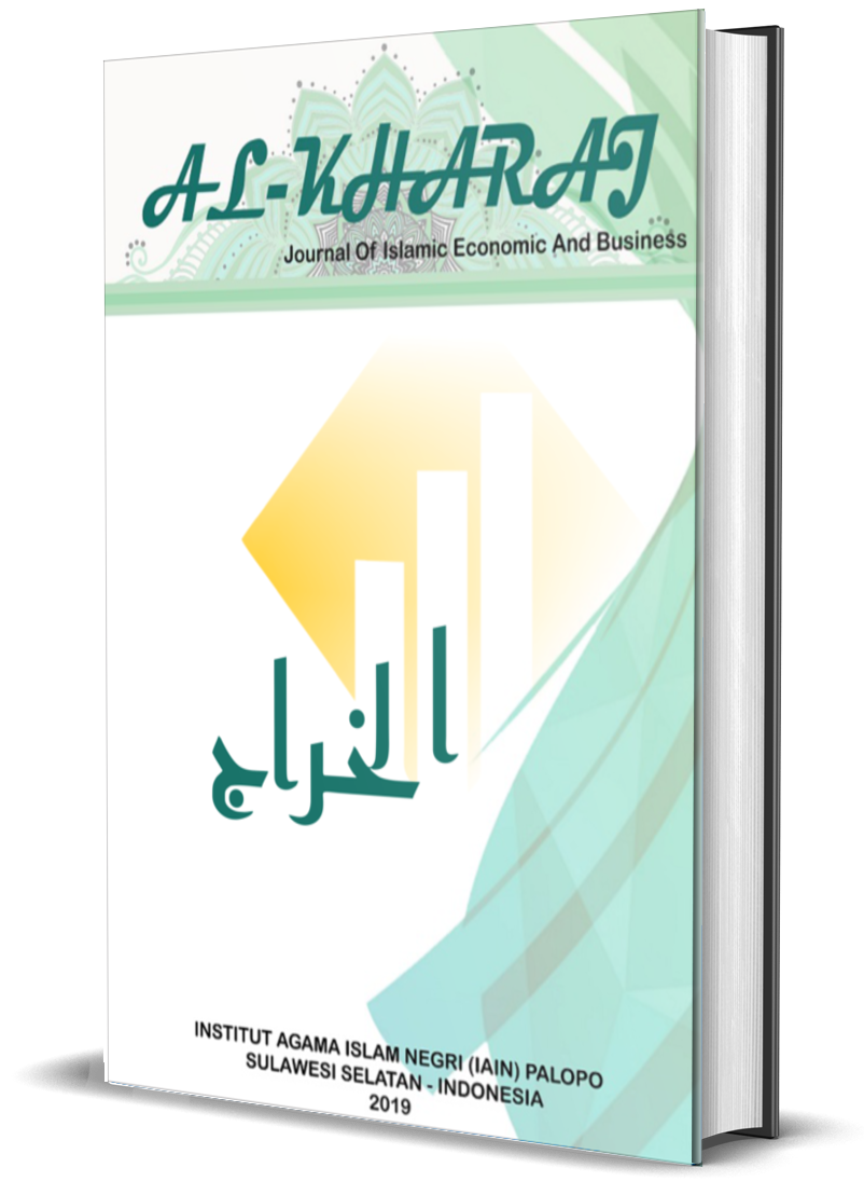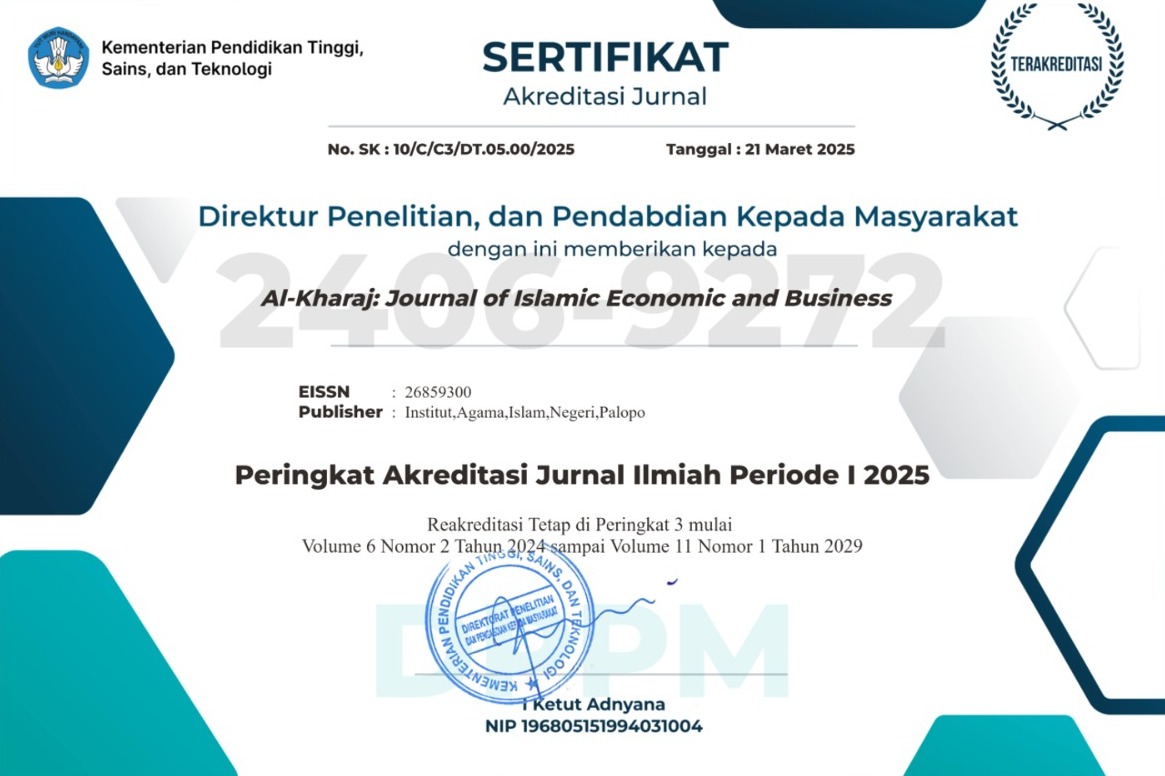Compensation Analysis in Improving Employee Performance at Bank Muamalat, Baturaja City
DOI:
https://doi.org/10.24256/kharaj.v7i3.7826Keywords:
Kompensasi Karyawan, Kinerja Karyawan, Manajemen SDM, Perbankan SyariahAbstract
This study examines the employee compensation system at Bank Muamalat in Baturaja City using a descriptive qualitative approach, combining a socio-historical perspective and Islamic values in compensation practices in Islamic banking. The compensation analyzed includes direct compensation (salary and incentives) and indirect compensation (allowances, facilities, and Umrah pilgrimage). The results show that a fair, timely, and Islamically sound compensation system contributes significantly to improving employee motivation, well-being, and performance. Comprehensive and transparent performance assessments also support rational and accountable compensation. These findings reinforce the importance of integrating moral and religious values in Islamic banking human resource management to achieve high productivity and loyalty.
References
Abdurrahman. (2003). Metodologi Penelitian. Jakarta: Rineka Cipta.
Adams, J. S. (1965). Inequity in social exchange. In L. Berkowitz (Ed.), Advances in Experimental Social Psychology (Vol. 2, pp. 267–299). New York: Academic Press.
Al-Jalalain. (2025). Tafsir Al-Jalalain. Jakarta: Pustaka Amani.
Arrizal, A. (1999). Motivasi Kerja dalam Perspektif Manajemen. Jakarta: Bumi Aksara.
Campbell, J. P., McCloy, R. A., Oppler, S. H., & Sager, C. E. (1993). A theory of performance. In N. Schmitt & W. C. Borman (Eds.), Personnel Selection in Organizations (pp. 35–70). San Francisco: Jossey-Bass.
Danim, S. (2002). Menjadi Peneliti Kualitatif. Bandung: Pustaka Setia.
Dessler, G. (2007). Human Resource Management (11th ed.). Upper Saddle River, NJ: Prentice Hall.
Dessler, G. (2017). Human Resource Management (15th ed.). Boston: Pearson.
Fatmawati, D., Nazmi, I., & Falah, N. (2025). Human resource performance management strategies to enhance employee retention through job satisfaction. Journal of Economics and Management, 3(1), 21–27. https://doi.org/10.70716/ecoma.v3i1.137
Frista Adela. (2025). Wawancara Customer Service Bank Muamalat Kota Baturaja, 17 Januari 2025.
Hariandja, M. T. E. (2002). Manajemen Sumber Daya Manusia: Pengadaan, Pengembangan, Pengkompensasian, dan Peningkatan Produktivitas Pegawai. Jakarta: Grasindo.
Hasibuan, M. S. P. (2002). Manajemen Sumber Daya Manusia. Jakarta: Bumi Aksara.
Herzberg, F. (1966). Work and the Nature of Man. Cleveland, OH: World Publishing.
Husnan, S. (2002). Manajemen Sumber Daya Manusia. Yogyakarta: BPFE.
Jotabá, M. N., Fernandes, C. I., Gunkel, M., & Kraus, S. (2022). Innovation and human resource management: A systematic literature review. European Journal of Innovation Management, 25(6), 1–18. https://doi.org/10.1108/EJIM-07-2021-0330
Kurnianto, A. (2009). Manajemen Kompensasi dan Kinerja. Yogyakarta: Graha Ilmu.
Malik, A. (2009). Pengantar Manajemen Sumber Daya Manusia. Jakarta: Rajawali Pers.
Mardalis. (2004). Metode Penelitian Suatu Pendekatan Proposal. Jakarta: Bumi Aksara.
Nawawi, H. (2001). Manajemen Sumber Daya Manusia untuk Bisnis yang Kompetitif. Yogyakarta: Gadjah Mada University Press.
Prawirosentono, S. (1999). Manajemen Sumber Daya Manusia: Kebijakan Kinerja Karyawan. Yogyakarta: BPFE.
Rachmawati, R. (2025). Employee experiences with HRM policy changes in Indonesian technology companies: A phenomenological study. Journal of Business, Management, and Accounting, 1(2).
Rahman, F. (2005). Islam dan Perubahan Sosial. Jakarta: Pustaka Firdaus.
Rinaldi. (2025). Wawancara Subbranch Manager Bank Muamalat Kota Baturaja, 16 Januari 2025.
Robbins, S. P., & Judge, T. A. (2016). Organizational Behavior (17th ed.). Boston: Pearson.
Robi Syahputra. (2025). Wawancara Supervisor Bank Muamalat Kota Baturaja, 16 Januari 2025.
Schermon, G. (2011). Human Performance and Productivity. London: Routledge.
Shaha, F. (2023). Twenty-years journey of sustainable human resource management research: A bibliometric analysis. Administrative Sciences, 13(6), 139. https://doi.org/10.3390/admsci13060139
Simarmata, J. (2023). HRM practices, human capital, individual performance, and organizational performance: An empirical evidence from Indonesian SMEs. Greenation International Journal of Tourism and Management, 1(2), 78–91. https://doi.org/10.38035/gijtm.v1i2.25
Sugiyono. (2009). Metode Penelitian Pendidikan: Pendekatan Kualitatif, Kuantitatif, dan R&D. Bandung: Alfabeta.
Terry, G. R. (2000). Principles of Management. Homewood, IL: Richard D. Irwin.
Wiyono, D., Dewi, D. A., Ambiapuri, E., Parwitasari, N. A., & Hambali, D. S. (2025). Strategic ESG-driven human resource practices: Transforming employee management for sustainable organizational growth. arXiv Preprint. https://arxiv.org/abs/2505.08201
Zebua, D. K., Santosa, A., Putra, F. D., & Framulya, N. (2024). The role of HR analytics in enhancing organizational performance: A review literature. Indonesia Journal of Engineering and Education Technology (IJEET), 2(2), 363–368. https://doi.org/10.61991/ijeet.v2i2.69
Downloads
Published
How to Cite
Issue
Section
Citation Check
License
Copyright (c) 2025 Dedi Siswanto, Nurma Nirmala, Sayu Mainingsih

This work is licensed under a Creative Commons Attribution-ShareAlike 4.0 International License.
Authors retain copyright and grant the journal right of first publication with the work simultaneously licensed under a Creative Commons Attribution-ShareAlike 4.0 International License. In line with the license, authors are allowed to share and adapt the material. In addition, the material must be given appropriate credit, provided with a link to the license, and indicated if changes were made. If authors remix, transform or build upon the material, authors must distribute their contributions under the same license as the original.









